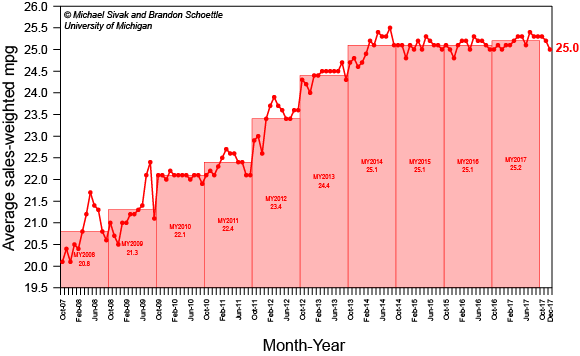** Sustainable Worldwide Transportation ended its operation in March 2018. **
Sustainable
Worldwide
|
|
Sales-weighted fuel-economy rating (window
sticker) of purchased new vehicles The sales-weighted fuel economy was calculated from the monthly sales of individual models of light-duty vehicles (cars, SUVs, vans, and pickup trucks) and the combined city/highway fuel-economy ratings published in the EPA Fuel Economy Guide (i.e., window sticker ratings) for the respective models. For both monthly and model year averages, sales-weighted arithmetic means were calculated. (The arithmetic mean was used here to determine the average of window sticker ratings, not the average fuel consumption rate.) The bars in the graph show the average for each model year. Vehicles purchased from October 2007 through September 2008 were assumed to be model year 2008. Analogous assumptions were made for vehicles purchased in each following model year. The fuel-economy information was available for 99.5% of vehicles purchased. For cases in which the EPA Fuel Economy Guide contained multiple fuel-economy ratings for a vehicle model, the average of these ratings was used (without regard to sales figures for each specific engine or vehicle-model variant). Additionally, when a vehicle model was sold during a particular model year but it is not listed in that year’s EPA Fuel Economy Guide, the fuel-economy rating(s) from the most recently available year were used. Finally, for very low sales-volume manufacturers (e.g., Ferrari, Rolls-Royce, etc.), all vehicle models for that manufacturer were aggregated and one average fuel-economy rating was calculated. Analogously, the sales figures for such manufacturers and models were also aggregated each month. (Data for recent months are occasionally updated in the underlying EPA data source, possibly resulting in small changes to recent fuel economy values.) For model year 2017, the EPA revised its methodology for calculating the window-sticker fuel-economy value for new vehicles. In order to make the data for previous model years comparable with model year 2017 (and future model years), the EPA also retroactively revised the corresponding data for some vehicles in model years 2011-2016. Our calculations incorporate these revisions. For more information, please visit: http://www.fueleconomy.gov/feg/ratings.shtml Latest data: December 2017. Last updated: January 4, 2018.
|
(click on the graph to view full size)

![]() Download the current sales-weighted fuel-economy data
Download the current sales-weighted fuel-economy data
(UMTRI_sales-weighted-MPG_December-2017.xls)
| Year | Month | |||||||||||
| Jan | Feb | Mar | Apr | May | Jun | Jul | Aug | Sep | Oct | Nov | Dec | |
| 2007 | 20.1 | 20.4 | 20.1 | |||||||||
| 2008 | 20.5 | 20.4 | 20.8 | 21.2 | 21.7 | 21.4 | 21.3 | 20.8 | 20.6 | 21.0 | 20.7 | 20.5 |
| 2009 | 21.0 | 21.0 | 21.2 | 21.2 | 21.3 | 21.4 | 22.1 | 22.4 | 21.1 | 22.1 | 22.1 | 22.0 |
| 2010 | 22.2 | 22.1 | 22.1 | 22.1 | 22.1 | 22.0 | 22.1 | 22.1 | 21.9 | 22.1 | 22.2 | 22.1 |
| 2011 | 22.3 | 22.5 | 22.7 | 22.6 | 22.6 | 22.4 | 22.4 | 22.1 | 22.1 | 22.9 | 23.0 | 22.6 |
| 2012 | 23.4 | 23.7 | 23.9 | 23.7 | 23.6 | 23.4 | 23.4 | 23.6 | 23.6 | 24.3 | 24.2 | 24.0 |
| 2013 | 24.4 | 24.4 | 24.5 | 24.5 | 24.5 | 24.5 | 24.5 | 24.7 | 24.3 | 24.7 | 24.8 | 24.6 |
| 2014 | 24.7 | 24.9 | 25.2 | 25.1 | 25.4 | 25.3 | 25.3 | 25.5 | 25.1 | 25.1 | 25.1 | 24.8 |
| 2015 | 25.1 | 25.0 | 25.2 | 25.0 | 25.3 | 25.2 | 25.1 | 25.1 | 25.0 | 25.1 | 25.0 | 24.8 |
| 2016 | 25.1 | 25.2 | 25.2 | 25.0 | 25.3 | 25.2 | 25.2 | 25.1 | 25.0 | 25.0 | 25.1 | 25.0 |
| 2017 | 25.1 | 25.1 | 25.2 | 25.3 | 25.3 | 25.1 | 25.4 | 25.3 | 25.3 | 25.3 | 25.2 | 25.0 |
Publications | Fuel economy and emissions monitoring | Contact us
Page updated: Tuesday, April 3, 2018
Copyright © 2006-2018 The Regents of the University of Michigan, Ann Arbor, MI 48109 USA